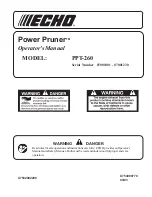
10
English
FIG. 31
FIG. 32
D
E
A4
A3
NOTE:
This fence will allow the guard to remain on the saw when completing narrow ripping.
This fence will provide ample space for a push stick. If you prefer more clearance for push
blocks or push sticks, refer to
Narrow Rip Auxiliary Fence
.
FINE ADJUSTMENT KNOB (FIG. 31)
The fine adjustment knob (D) allows smaller adjustments when setting the fence. Before
adjusting, be sure the rail lock lever is in its up or unlocked position.
RIP SCALE POINTER
The rip scale pointer will need to be adjusted for proper performance of the rip fence if the
user switches between thick and thin kerf blades. The rip scale pointer only reads correctly
for position 1 (0 to 24.5"), however for position 1 with narrow rip fence in use add 2" (50 mm).
See
Adjusting the Rip Scale
under
Assembly
.
Ripping (Fig. 33)
WARNING:
Never touch the “free end” of the workpiece or a “free piece” that is cut off,
while the power is ON and/or the saw blade is rotating. Piece may contact the blade resulting
in a thrown workpiece and possible injury.
WARNING:
A rip fence should
ALWAYS
be used for ripping operations to prevent loss of
control and personal injury.
NEVER
perform a ripping operation freehand.
ALWAYS
lock the
fence to the rail.
WARNING:
When bevel ripping and whenever possible, place the fence on the side of the
blade so that the blade is tilted away from the fence and hands.
WARNING:
Keep hands clear of the blade.
WARNING:
Use a push stick to feed the workpiece if there is 2–6" (51–152 mm) between
the fence and the blade. Use a narrow ripping fence feature and push block to feed the
workpiece if there is 2" (51 mm) or narrower between the fence and the blade.
1. Lock the rip fence by pressing the rail lock lever down. Remove the miter gauge.
2. Raise the blade so it is about 1/8" (3.2 mm) higher than the top of the workpiece.
3. Hold the workpiece flat on the table and against the fence. Keep the workpiece about 1"
(25.4 mm) away from the blade.
FIG. 33 A
FIG. 33 B
On-Off Switch (Fig. 29)
WARNING:
To reduce the risk of injury,
be sure the switch
FIG. 29
H
is in the OFF position before plugging machine in.
Push green button (H) in to turn this saw on and push down the
red paddle to turn this saw off.
LOCK OFF FEATURE INSTRUCTIONS
A cover above the switch folds down for insertion of a padlock
to lock the saw off. A padlock with a maximum diameter of
1/4" (6.35 mm) and minimum clearance of 3" (76.2 mm) is
recommended.
Guard Operating Feature (Fig. 30)
WARNING: To reduce the risk of injury, turn unit off and disconnect machine from
power source
before installing and removing accessories, before adjusting or changing set-
ups or when making repairs. An accidental start-up can cause injury.
1. The guard(s) will lock in place when in the raised position.
2. This feature increases visability when measuring the blade to fence distance.
3. Push down on guard(s) and they will release to the operating position.
NOTE:
Pull on the anti-kickback assembly to ensure it is locked in place.
ALWAYS
make sure both guards are in the down position in contact with the table before
operating.
FIG. 30
RAISED
POSITION
OPERATING
POSITION
Rip Fence Operation (Fig. 31–33)
RAIL LOCK LEVER (FIG. 32)
The rail lock lever (E) locks the fence in place preventing movement during cutting.
To lock
the rail lever,
push it down and toward the rear of the saw.
To unlock,
pull it up and toward
the front of the saw.
NOTE:
When ripping, always lock the rail lock lever.
WORK SUPPORT EXTENSION/NARROW RIPPING FENCE
The table saw is equipped with a narrow ripping fence that also supports work that extends
beyond the saw table.
To use the narrow ripping fence in the work support position, rotate it from its stored position
as shown in Figure 31, and slide the pins into the lower sets of slots (A3) on both ends of the
fence.
To use the narrow ripping fence in the narrow ripping position, snap the pins into the upper
sets of slots (A4) on both ends of the fence.
This feature will allow 2" (51 mm) of extra clearance to the blade. Refer to figure 33 B. If more
clearance is necessary, follow directions for making an auxiliary fence under
Narrow Rip
Auxiliary Fence
in the
Operation
section.
NOTE:
When not in use, the narrow ripping fence should be placed in its stored position.













































